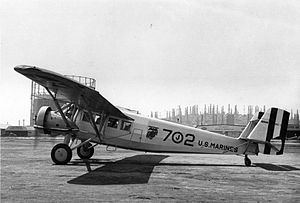The Curtiss Model 55 Kingbird was an airliner built in small numbers in the United States in the early 1930s. It was a twin-engine aircraft with a fuselage derived from the single-engine Curtiss Thrush. The Kingbird had two engine nacelles mounted on the struts on either side of the fuselage that braced the wing and the outrigger undercarriage. A distinctive design feature was the aircraft's blunt nose, located behind the propeller arcs. This allowed the engines to be mounted closer to each other and to the aircraft's centerline, therefore minimising asymmetrical thrust in case of an engine failure. For the same reason, the Thrush's single tailfin was replaced by twin tails on the Kingbird, and the main production model, the D-2 fitted a second horizontal stabilizer and elevator between these fins.
Eastern Air Transport was to be the Kingbird's main operator, flying 14 of them for a few years. The United States Marine Corps also purchased an example, first designating it JC-1, then RC-1 and using it as an air ambulance.
Kingbird CPrototype powered by 185 hp (138 kW six-cylinder Curtiss R-600 Challenger engines. One built, but found to be underpowered. Later converted to Kingbird J-1.
Kingbird D-1Second and third prototypes (previously Kingbird J-3 and J-2) powered by 225 hp nine-cylinder Wright Whirlwind J-6-7
radial engines. Later converted to D-2 standard.
Kingbird D-2Production aircraft with two 300 hp (224 kW) Whirlwind J-6-9 engines. 14 built plus two converted from D-1s.
Kingbird D-3One-off Curtiss executive transport. Two 330 hp (246 kW) Whirlwind J-6-9 engines. Seats for five passengers.
Kingbird J-1First prototype after re-engining with Whirlwind engines.
Kingbird J-2Third prototype, J-6-7 engines.
Kingbird J-3Second prototype, J-6-9 engines.
RC-1Single Kingbird D-2 for US Navy, originally ordered as
JC-1 (J for utility), but delivered as
RC-1 (R for transport).
United StatesEastern Air TransportUnited States Marine Corps TurkeyTurkish Airlines (under former official name: State Airlines Administration)Data from Curtiss Aircraft, 1907–1947
General characteristics
Crew: one, pilotCapacity: seven passengersLength: 34 ft 10 in (10.59 m)Wingspan: 54 ft 6 in (16.61 m)Height: 10 ft in (3.04 m)Wing area: 405 ft2 (37.6 m2)Empty weight: 3,442 lb (1,561 kg)Gross weight: 5,202 lb (2,360 kg)Powerplant: 2 × Wright J-6-9 Whirlwind radial engine, 300 hp (224 kW) each eachPerformance
Maximum speed: 142 mph (229 km/h)Cruise speed: 112 mph (180 km/h)Range: 415 miles (668 km)Service ceiling: 16,000 ft (4,880 m)Rate of climb: 1,000 ft/min (5.08 m/s) 
